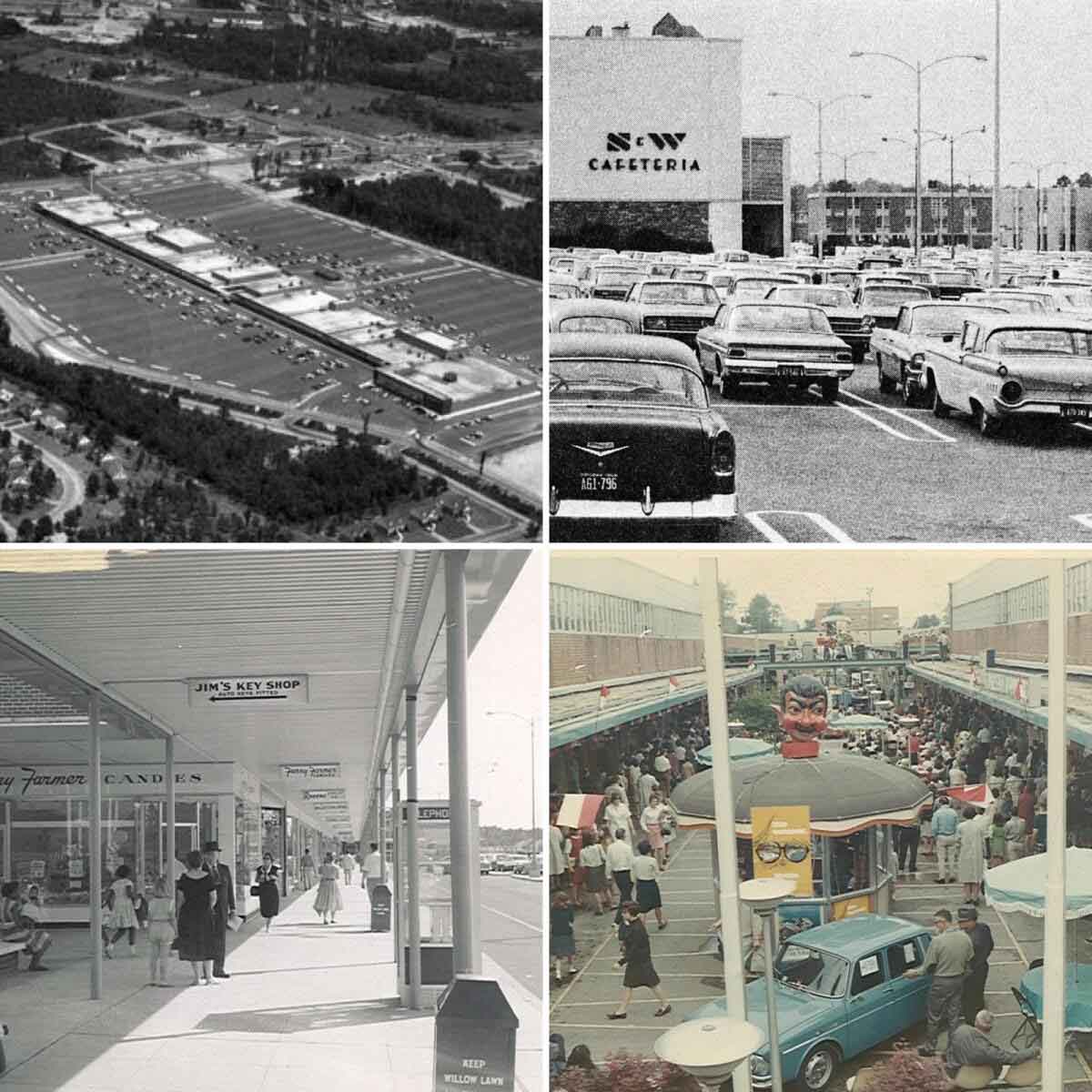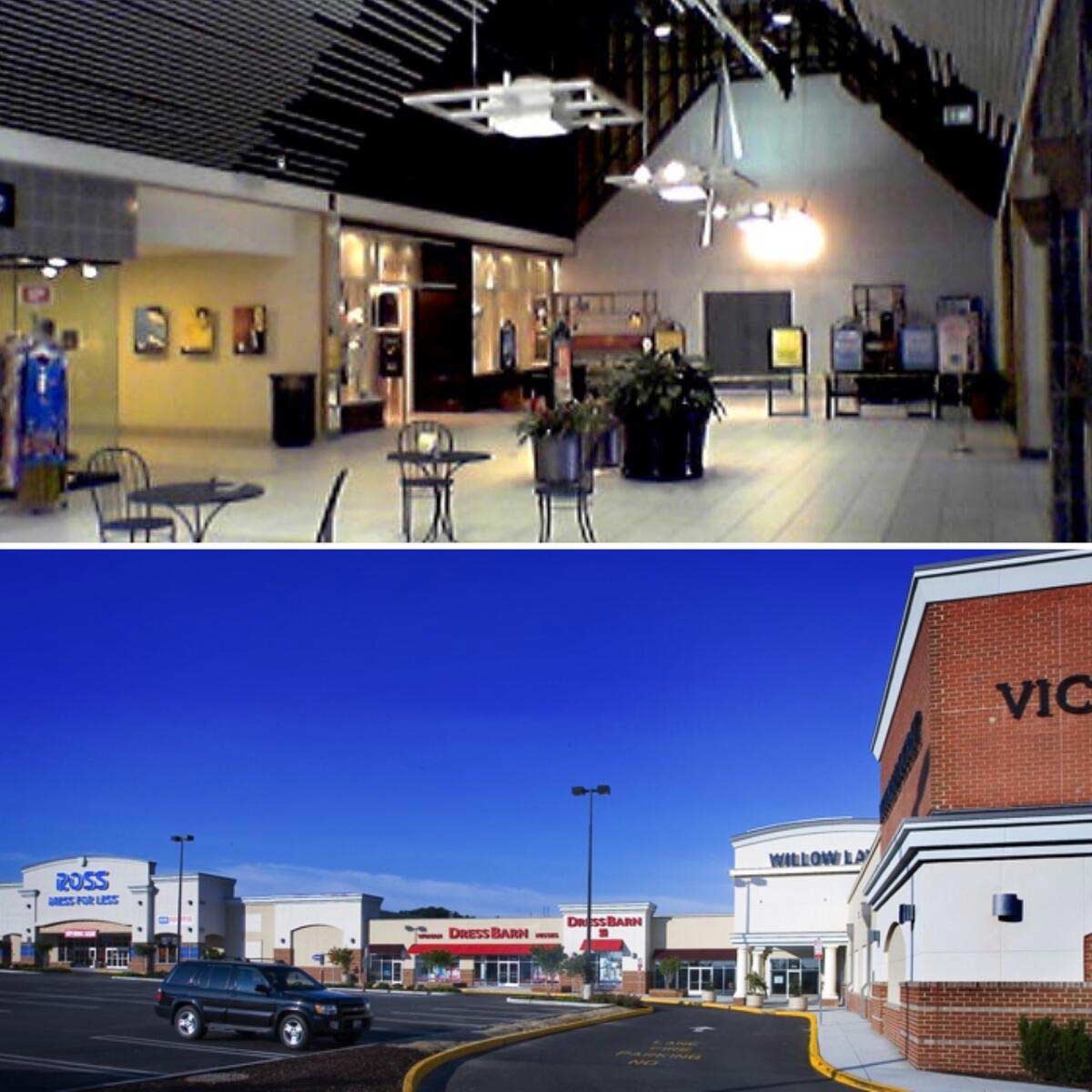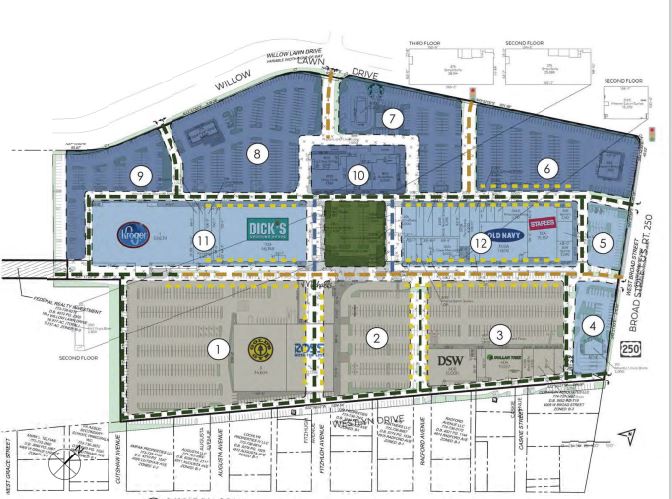- Navigator
- Real Estate Development and Housing
- Retail, Services, and Accommodations
Welcome to the final installment in my series on the impact and redevelopment of American shopping malls over the past several decades. If you’ve read the previous three articles, you will recall that Part 1 provided a comprehensive history of the shopping mall, exploring its impact on both pop culture and the economy. The next two articles focused on my hometown, Richmond, VA, spotlighting the exciting redevelopments happening at local malls that hold a special place in my childhood memories.
This final article will examine a third landmark mall in the Richmond area and how it has managed to remain open and relevant in the ever-changing landscape of consumer shopping and needs since its opening in the late 1950s.
Reinventing Willow Lawn
Upper right and both bottom photos are courtesy of Sarah North, Senior Director Marketing, Federal Realty
Originally known as Willow Lawn Shopping Center, Willow Lawn was the first shopping center to be built in the Richmond area, opening in 1956. It had an open-air design and included anchor stores such as G.C. Murphy, Giant Food, JCPenney, Peoples Drug, Safeway, and Woolworth’s. The mall also has a movie theater, The Willow Lawn Theatre, and duckpin bowling, Willow Bowl. Miller & Rhodes department store opened in 1961.
Up until the 1980s the mall changed very little. Then in 1986, Federal Realty Trust acquired the shopping center. To keep it competitive with other malls that were opening in the area, the shopping center underwent a renovation project that enclosed the middle section of the mall, creating both an open-air strip mall and an enclosed mall in one location. The enclosed portion featured several more stores, as well as a food court. The mall’s name was changed to The Shops at Willow Lawn. Photos courtesy of Sarah North, Senior Director Marketing, Federal Realty
Photos courtesy of Sarah North, Senior Director Marketing, Federal Realty
As with the malls featured in my previous articles, The Shops at Willow Lawn experienced several changes in major retail and anchor stores over the years:
- JCPenney, a 37-year tenant, left the mall in 1994 relocating to Virginia Center Commons. The site was demolished in 1996 and replaced with a Hannaford’s grocery store until 2000 when it became Kroger.
- Woolworth’s closed, and the storefront hosted several businesses before Dick’s Sporting Goods opened in 2018.
- Miller & Rhoads, the center’s primary anchor for almost 30 years, closed in 1989. The space was repurposed and subdivided into smaller stores, offices, and restaurants.
- G.C. Murphy was acquired by Ames Department Stores in 1985 and was later sold to McCrory’s in 1989. In the years since, the space transformed into multiple storefronts. Presently, this location is home to a few different retailers, including Chick-fil-A, LensCrafters, and Claire’s, among others. This location was originally located in the section of the mall that was enclosed in 1986.
- Giant Food closed in 1982. It later became Safeway and then was split into two stores: Barnes & Noble from the mid-1990s to 2000, Tower Bookstore from 2000 to 2003, and Tower Records from 1994 to 2006. Staples opened in 2004 and then came Old Navy in 2011. The Old Navy also took over part of the former Peoples Drug, which became CVS Pharmacy in 1994 and was located at the center until 2008.
- Originally Safeway, Hess’s, Leggett’s, Belk, and Dillard’s used the same location from 1987 to 2003 when it relocated to Short Pump Town Center. Both Gold’s Gym and Ross Dress for Less took over the space in 2006.
- The Willow Lawn Theatre closed in 1989. The site was demolished and replaced with Regal Willow Lawn Cinemas, which operated from 1990 to 2001.
Another renovation occurred at Willow Lawn in 2005, which turned part of the enclosed mall near one of the entrances into an open-air space again and added parking spaces. The remainder of the enclosed mall was remodeled as well. Photo Credits: Top – “Enclosed Portion of The Shops at Willow Lawn” by Ben Schumin is licensed under Creative Commons BY-SA 2.0 Deed; Bottom: Photo courtesy of Sara North, Senior Director Marketing, Federal Realty
Photo Credits: Top – “Enclosed Portion of The Shops at Willow Lawn” by Ben Schumin is licensed under Creative Commons BY-SA 2.0 Deed; Bottom: Photo courtesy of Sara North, Senior Director Marketing, Federal Realty
In 2011, a third renovation project took place, which involved demolishing the remaining enclosed section of the mall. This transformation brought the mall back to a structure resembling its original design.
New amenities that came with that renovation included an outdoor community gathering space with a children’s play area and a central stage for events and displays. The center’s name was also updated to just Willow Lawn. Many of the stores in the enclosed mall section were relocated to become part of the new open-air shopping center.
Today, Willow Lawn is home to nearly 50 shops and restaurants. Major tenants include Kroger, Dick’s Sporting Goods, Ross Dress for Less, Gold’s Gym, Staples, and Old Navy.
Willow Lawn’s Next Chapter: Vision for a Dynamic Mixed-Use District
In October 2023, the Henrico County Planning Commission’s Board of Supervisors approved a rezoning request to redevelop the Willow Lawn shopping center yet again.
The proposed plan by Federal Realty Investment Trust will take the shopping center’s 37 acres and turn it into a new mixed-use district that will include over 2,200 residential housing units and multiple stand-alone buildings, one being a 10-story tower with ground-floor retail and upper-level office space. This redevelopment, which is planned to occur over the next 20 to 30 years, would be the largest in the shopping mall’s almost 70-year history. Source: Henrico County, VA
Source: Henrico County, VA
A planning document submitted to the Henrico County zoning office in late 2023 includes conceptual illustrations for streetscape options, landscaping, architecture style, street lighting and furniture, bike and pedestrian areas, outdoor amenities, and parking garages.
Willow Lawn’s Appeal for Growth and Investment
Willow Lawn is positioned as a dynamic hub for growth and investment due to its strategic location with convenient accessibility and visibility, demographic trends indicating population growth, favorable consumer spending patterns, and the potential for mixed-use development incorporating residential, office, and recreational spaces for a vibrant and sustainable environment.
Just over 9,500 people reside within one mile of the mall, and almost 98,000 people live within three miles, with the daytime population surging to over 24,000 within a one-mile radius. Situated on West Broad Street near a major commercial artery and offering convenient access to Interstate 64, the shopping center enjoys a favorable location between downtown Richmond and Short Pump, attracting customers from both the city and the county.
Willow Lawn’s accessibility is further complemented by the GRTC Pulse Bus Rapid Transit route, which includes a stop right at the center. Additionally, the presence of new and expanding mixed-use development at Libbie Mill, just over a mile away, adds to the area’s vibrancy and appeal.
Advantages of Continued Mall Redevelopment
Mall redevelopment provides opportunities to transform underutilized spaces, stimulate economic activity, and create vibrant, mixed-use environments that cater to changing consumer preferences and retail trends. It attracts new businesses, increases foot traffic, and revitalizes surrounding neighborhoods.
The specific advantages of converting a shopping mall into a mixed-use development include:
- Diversification of Land Use: Incorporating residential, commercial, and office space alongside retail allows for a more diversified use of the land and creates a multifaceted environment.
- Greater Economic Stability: Reducing dependence on a single industry with diverse revenue streams helps provide economic sustainability in economic downturns or shifts in consumer behavior.
- Attracting a Wider Customer Base: Residential units attract residents, office spaces draw workers, and retail and entertainment options bring in visitors. This creates a more vibrant environment, attracting a diverse customer base.
- Increased Tax Revenue: The combination of residential and commercial properties contributes to higher property values and business activity resulting in a more robust tax base.
- Enhanced Community Spaces: Mixed-use developments often include vibrant gathering spaces, such as parks, plazas, or recreational areas, which contribute to a sense of community togetherness.
- Additional Job Creation: The combination of retail, commercial, and office space generates employment opportunities for the local community.
- Adaptive Reuse of Existing Space: Integrating various land uses often involves adaptive reuse of existing structures, which can be more sustainable and cost-effective than building entirely new developments.
- Improved Walkability and Connectivity: Pedestrian-friendly environments with easy access to various amenities contribute to a more enjoyable community and help support location businesses.
- Long-Term Viability: Mixed-use developments cater to changing lifestyle trends and market demands, allowing for adjustments over time to meet evolving economic and social needs.
Other Mixed-Use Mall Redevelopments Across the United States
Arizona: Kimco Realty plans to replace the closed Costco Auto Center at the Christown Spectrum Shopping Center in Phoenix with a 760-unit apartment complex, marking the initial phase of a 20 to 25-year redevelopment effort. The larger vision for Christown Spectrum includes reimagining the mall with a mix of apartments, a pedestrian plaza, commercial space, retail, offices, and entertainment.
California: In 2021, the Citrus Heights City Council approved a plan to revitalize the 100-acre Sunrise Mall. The redevelopment plan aims to transform the mall into a mixed-use destination with a walkable main street, reducing retail space and introducing housing, hotels, offices, and additional dining and entertainment options.
Illinois: The Westfield Old Orchard Shopping Mall in Skokie is set to undergo a major redevelopment, featuring best-in-class retail, modern residences, chef-led dining, entertainment, gourmet markets, upscale health and wellness amenities, and a public park.
Maryland: Trademark Property Co.’s redevelopment efforts at the Annapolis Town Center in Maryland have resulted in new leases for retail, restaurants, and fitness tenants. The mixed-use property now features increased community green space with Green Village, including a Boat House Pavilion, outdoor ice-skating rink, and a performance stage, along with a climate-controlled paseo connecting parking and retail areas.
Wisconsin: Bayshore Town Center in Glendale has been transformed into an open-air mixed-use complex. The project included the construction of 13 buildings, doubling the mall’s size to over 1.1 million square feet, featuring more than 60 retail stores, offices, and residential units.
The shopping mall, as we have explored in this series, has played a pivotal role in shaping American pop and economic culture since the opening of the Southdale Regional Shopping Center in 1956. Business Insider noted that approximately three new shopping centers were opening every day in the US since 1956, reaching a total of 4,500 large shopping complexes by 1960. And by the mid-1980s, malls and shopping centers accounted for 52% of all US retail sales.
For those of us in our late 30s and beyond, the memory of bustling malls remains vivid, recalling a time when they weren’t just shopping destinations but vibrant community hubs. Malls weren’t merely places to shop for clothes; they had stores for books, music, electronics, beauty needs, toys, and more. They were social hubs where you could work, hang out with friends, get your ears pierced, enjoy a meal, and even catch a movie or visit an arcade. All these retailers and services, conveniently clustered in one location, significantly influenced how and where consumers spent time and money.
When enclosed malls were originally constructed, the emphasis was primarily on retail, with only a handful of dining options. But, as I mentioned in my first article, malls were designed to accommodate many tenants and uses, with ample square footage, parking, and infrastructure for a range of non-retail functions. So as consumer preferences evolved, malls adapted, repurposing spaces for different needs, demolishing underutilized areas, or reinventing existing spaces to stay relevant. The contemporary mall landscape includes new “anchor stores” transforming these spaces into areas where people can play, work, and even live.
What do you think? Are the days of the mall rat officially over? Or is this simply a reinvention of the mall experience — one that differs from what our parents, or even we, once knew?
Additional Reading About Willow Lawn:
“Richmond’s Oldest Shopping Center Continues to Thrive Through Evolution,” RVANews (November 24, 2014)
“Willow’s Revival: Fifty Years Later, One of Richmond’s First Shopping Malls Returns to its Roots,” Style Weekly (February 16, 2011)
“From the Archives: 27 Photos of Willow Lawn,” Richmond Times-Dispatch (December 26, 2023) – Subscription required/paywall





